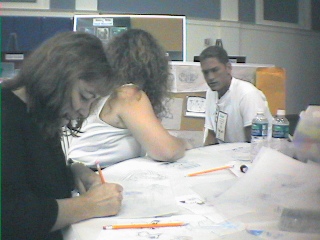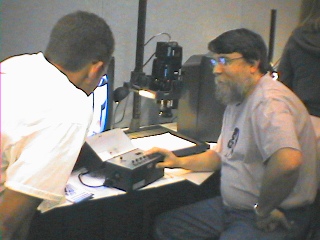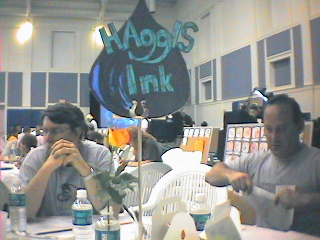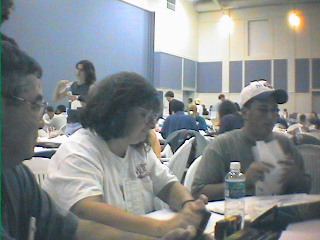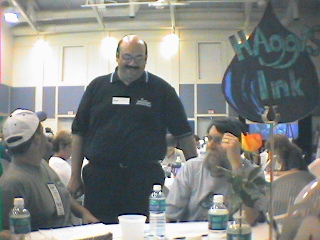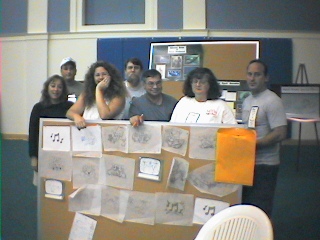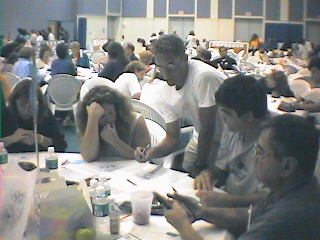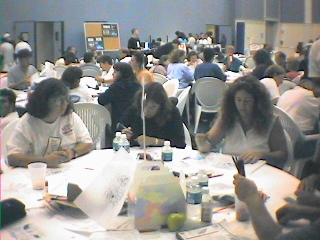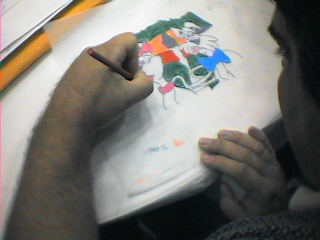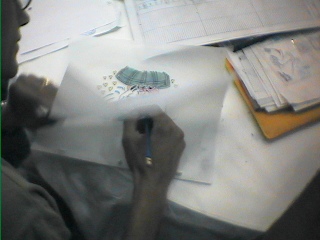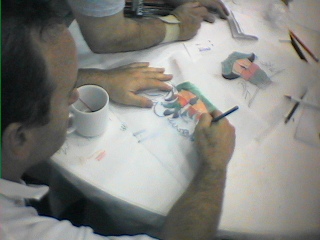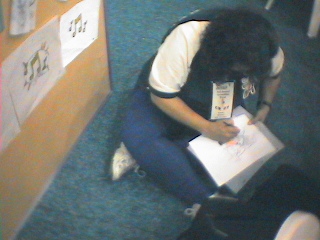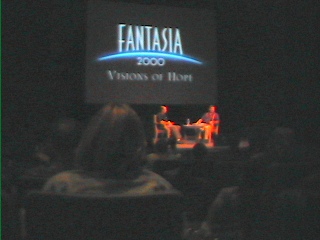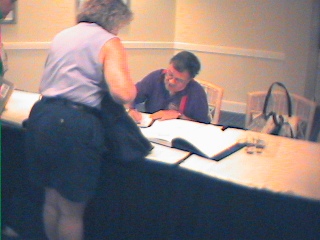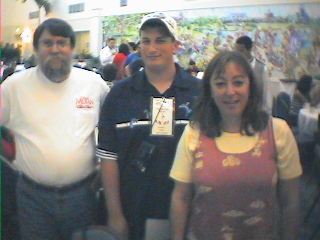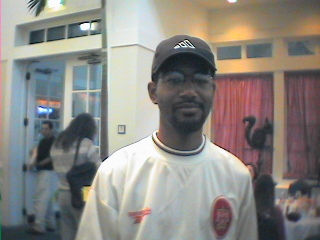I was enrolled in the Master classes which consisted of advanced workshops with some of the industry’s leading animators including Franics Glebas and Brian Mitchell. These particular workshops touched on the basics of not only animation but story-telling as well. I still have and refer to my notes from these workshops.
12 Basic Principles of Animation
Instructor: Brian Mitchell
Anticipation – direction of audience’s attention
Follow Through
Squash & Stretch – show weight and flexibility
Secondary Action – a primary action results in an additional action
Arcs – movement occurs in arcs (e.g. even in movement of jaw rather than just up and down
Silhouette – show depth of action or objects (e.g. move actions to the side); display the form and shape of objects
Overlapping Action – multiple actions occurring at once
Timing
24 frames per second (fps) for MOVIE
29.97 frames per second (fps) for VIDEO
30 frames per second (fps) for ANIMATION
10 frames per second (fps) for CHEAP ANIMATION
*50 fps is the limit for the human eye
Ones are used for fast action (a different action for every frame @30fps).
Twos are used for normal action (a different action for every two frames @30fps).
Threes are the limit for believable movement (a different action for every three frames @30fps).
A brisk walk is about a step every ½ second. The completion of normal action should be about ½ second. Very quick movement can occur in 6 frames (@30fps) if you use antic.
References
Disney Magic: The Illusion of Life (Johnston & Thomas)
Dynamics of Anatomy (Burne Hogarth)
Characteristics of Storytelling
Instructor: Francis Glebas
Narrative Theory
Describes who gets to know what and when.
Story Delaying
Can be used to build suspense. One scene delays the outcome of another. Can use parallel cutting to go between two scenes.
Story Compression
The act of removing non-essential action from a scene.
The Hero’s Journey
Represents the process of psychological growth. Seen in all cultural tales of heroes.
ACT I
1. Call to adventure
2. Initial refusal (or conflict)
3. Meet mentor
ACT II
4. Pass through threshold to CHAOS (guarded)
5. Testing and preparation
6. Supreme ordeal (face worst fear)
7. Sometimes a reward (macguffin) is given or hero faces consequences of ordeal
8. Pass back out of threshold (must die literally or symbolically)
ACT III
9. Rebirth
10. Maguffin transforms the ordinary world
Mentor – someone who used to be a hero
Macguffin – object or thing everyone desires to have e.g. Holy Grail
Acts I and III take place in the ORDINARY WORLD while Act II takes place in the UNDERWORLD (aka CHAOS or HELL). Act II is twice as long as Acts I and III. The level of interest should gradually rise peaking at halfway between Act II (the supreme ordeal). This peak should be maintained until halfway between Act III when it should again decrease.
Disney’s Hero’s Journey Outline
ACT I
Opening Image
Core Question
The calling, I want …
ACT II
Turning Point into the fire …
The Journey
Metaphoric plant
We can’t go back now
Let’s Rest/Sanctuary
It’s Hopeless (Hidden Treasure)
ACT III
Showdown with the Darkside
You get what you need
Happy Trails
Story Definitions
Subjective – feelings/opinions from one’s point of view
Objective – reality; “truth”
Symbolic – meaning, representation
Structural – framework and position (semiotics)
Semiotics – how signs signify (made up of signifier and signified)
Denotation – what something is meant to signify
Connotation – what a sign relates to or alludes to meaning
Sound – tells you how to feel
Pictures – tell you what’s going on
Director – directs the viewer’s attention/focus to a story; want to aim for subjective
Composition – the subtext that tells the audience how to feel by what you show
Drawing
Draw the story. Show position, emotion, expression, action and situation.
Enemies of Design
1. Boredom – put stuff in the picture
2. Chaos – be clear; focus the attention of the viewer
Haggis Ink
Each animation group was tasked with creating a 15 second animated clip based on a 15 second clip of music. The clip for each group had to start and end with the same drawn music notes seamlessly linking all of the clips together into a single montage. My group consisted of the following members:
- Cindy Chinn – an experienced artist and video game animator who designed the animated sequences for the Fremont Street Experience in Las Vegas at the time.
- Tim Kirch – an experienced artist and animator who was auditioning for an animator job with Disney
- Barbara Dale – a syndicated comicstrip artist and greeting card designer
- Peter Arniotis – a retired ConEd worker from New York and avid Disney fan
- Bill Bradfute – a mechanical engineer attending the event with his daughter
- Harold Noone – a Disney employee who attends all of the events
- Emma Radovich – a Disney employee who attends all of the events
- Greg Gosline – Young kid interested in animation
- Mike Allen – Can’t remember too much about him
While 15 seconds may seem like a short span of time, typically that would mean drawing 24 frames for each second (I believe we may have been allowed to cut this in half to 12 frames per second). This amounts to 360 frames (or 180 frames at 12 frames per second) that needed to be hand drawn, inked and colored in 4 days – not including the first day which was spent coming up with an idea, scripting and storyboarding the sequence. About 5 hours a day was set aside for working on the project, although you were free to spend more time if necessary if you skipped the evening lecture.
The music for our clip consisted of bagpipe music so we had an obvious Scottish angle we could use (it also became the inspiration for our group’s name). We came up with the idea of morphing the central note into a marching Scotsman’s legs and the two side notes into Scottish terriers. Barbara can be credited with coming up with the brief love story between the dogs and their subsequent (controversial?) upskirt viewing of the Scotsman’s kilt followed by him falling down to end the clip.
I was tasked with drawing the animation of the Scotsman marching at the beginning of the sequence. Brian Mitchell was our group’s advisor and gave me some good pointers and practical application of his earlier lecture on the “12 Basic Principles of Animation” when drawing this sequence. Since the marching sequence was repititive I only had to draw out enough frames for one cycle and we would reuse the previous frames when it came time to shoot the completed clip. Tim and Barbara drew the animations for the close-up of the dogs.
Equipment
We drew the sequence on standard semi-translucent animation paper clipped to the peg bar we received in our complimentary welcome kit. We drew with blue pencil and inked and colored the frames with standard felt tip markers. We had access to lightboxes but I don’t think my group ever used them. We also had access to a line tester so that we could quickly photograph and test our sequences. A good description of the equipment we used can be found on the following website – http://www.characteranimationin3d.com/2d%20animation%20equipment.htm.
Once we completed all of the drawings we had to number the frames so that the Disney Institute staff could film the final product (I think we had an X-sheet to fill out as well). The next morning we got to view the final completed sequence stitched together with the other groups’ work. In all it was a rewarding experience and it helped improve my technique and animation knowledge. Also I can’t forget the Survivor-style disagreements some of us got into (those in the group know what I am talking about). Fortunately we had Brian there to mediate and refocus us. Today the Disney Institute is the Sarasota Springs Resort & Spa but I am glad I was able to take part in this once in a lifetime unique experience.
